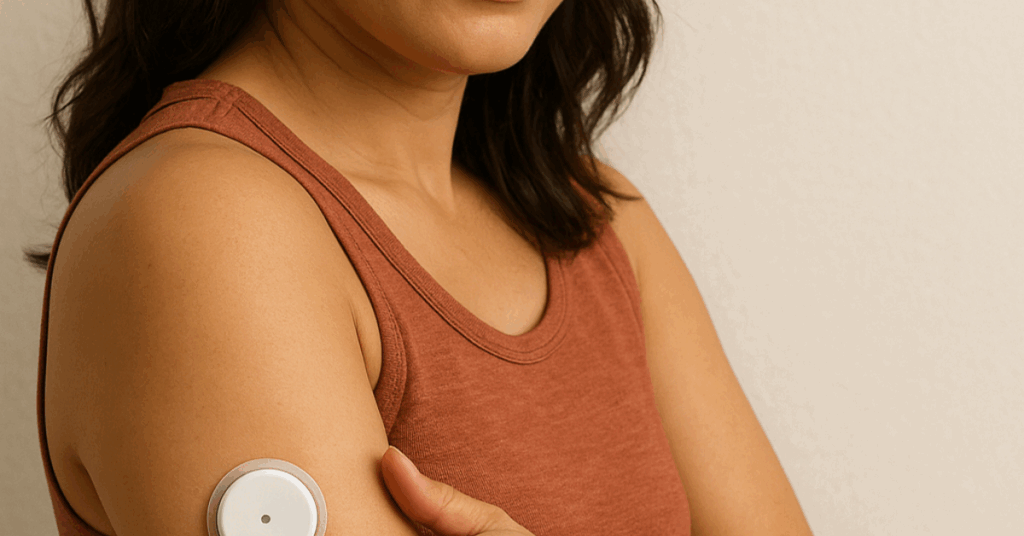Do Not Delete
If you’ve been scrolling through social media, you’ve probably seen people wearing Continuous Glucose Monitors (CGMs). They look sleek, high-tech, and they promise insight into how your body handles blood sugar in real time.
And maybe you’ve thought: “I should get one of those!”
Hold that thought for now.
CGMs can absolutely serve a purpose — but they aren’t the first place you need to start.

What a CGM Does (and Doesn’t Do)
A CGM is a small device worn on the arm or abdomen that tracks blood sugar levels around the clock. It shows you how food, sleep, stress, and movement affect your glucose patterns.
Sounds amazing, right? And for some people — like those with diabetes or advanced insulin resistance — it truly can be necessary and life-changing.
But here’s the catch:
- They give you data, not direction. A CGM tells you what’s happening, but not how to fix it.
- They can pull you away from your body. Watching numbers on a screen takes you outside of building a relationship with your body. It can distract from listening to your hunger cues, energy shifts, and mood patterns — the things that really teach you to reconnect and respond to your body’s needs.
They’re not foundational. If your diet is full of blood sugar-spiking foods, your sleep is off, and your stress is high, the numbers will reflect that. But you don’t need an expensive device to know those factors need support.
Why Starting with Awareness Matters
Here’s the truth: you don’t need a CGM to learn how your blood sugar is affecting you.
Your body already gives you clues:
- Energy crashes after meals
- Cravings that feel impossible to ignore
- Waking up at 3 a.m.
- Feeling shaky, irritable, or foggy between meals
These are powerful insights — and you don’t need a gadget to notice them.
By first understanding blood sugar and learning how to manage it, then paying attention to your body’s signals and making foundational shifts — balanced meals, regular eating rhythms, stress support, quality sleep — you begin to rebuild a healthier relationship with your body. Once you’ve cleared the muddy waters, a CGM can be a helpful next step. At that point, the information becomes more meaningful because the basics are already in place.
When a CGM Can Be Helpful
After your foundations are solid, a CGM can be a useful fine-tuning tool. It can highlight individual responses to certain foods (because bioindividuality is real!), show how your body reacts to exercise, or confirm progress you’ve already made.
But the key is timing. Using one before you’ve addressed the basics is like buying high-end running shoes before you’ve learned how to walk without tripping. The shoes aren’t bad — they’re just not the first step.
⏳ Your 5-Minute Action
Before considering a CGM, pause and check in with your body:
- Do you notice energy highs and lows throughout the day?
- How do you feel after meals — steady, sluggish, or crashing?
- Are your cravings guiding your choices, or do you feel in control?
Write down what you notice for a few days. This is your body’s built-in monitor — and it’s free.
You’re Not Alone
With all the marketing noise in the health space, it’s easy to feel like you need the latest gadget to get healthy — but the truth is, your body is already giving you the information you need. A CGM can be helpful down the road, but it’s not the starting line.
Start simple. Tune in. Build the foundations first. When you do, you’ll be amazed at how much progress is possible without spending money on a device.
Keep Reading
👉 Nutrition as Medicine– Reconnect with what food is really for.
👉 Core Health Principles – Shift from symptom-chasing to root-cause thinking.
👉 Lab Tests– Looking thru the lens of functional vs traditional pathological lab results.
👋 New to the blog?
This article is part of a bigger picture. Head over to the Start Here post to learn how the blog is organized and where to begin your healing journey.
Comments +